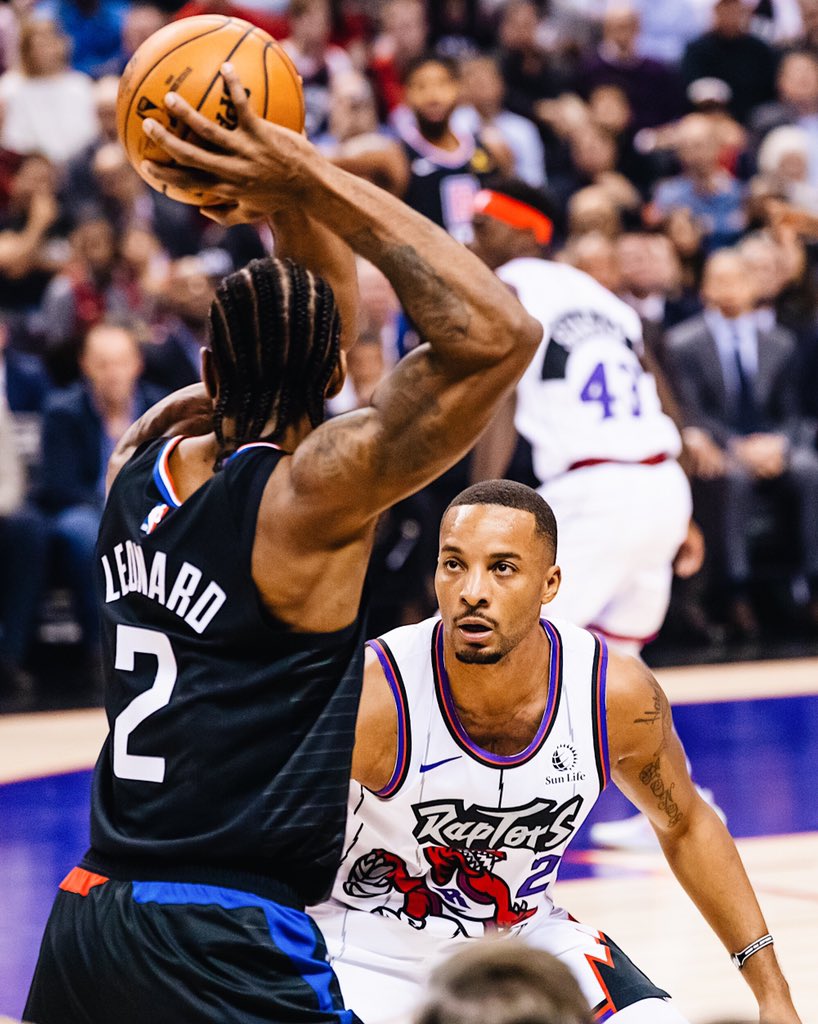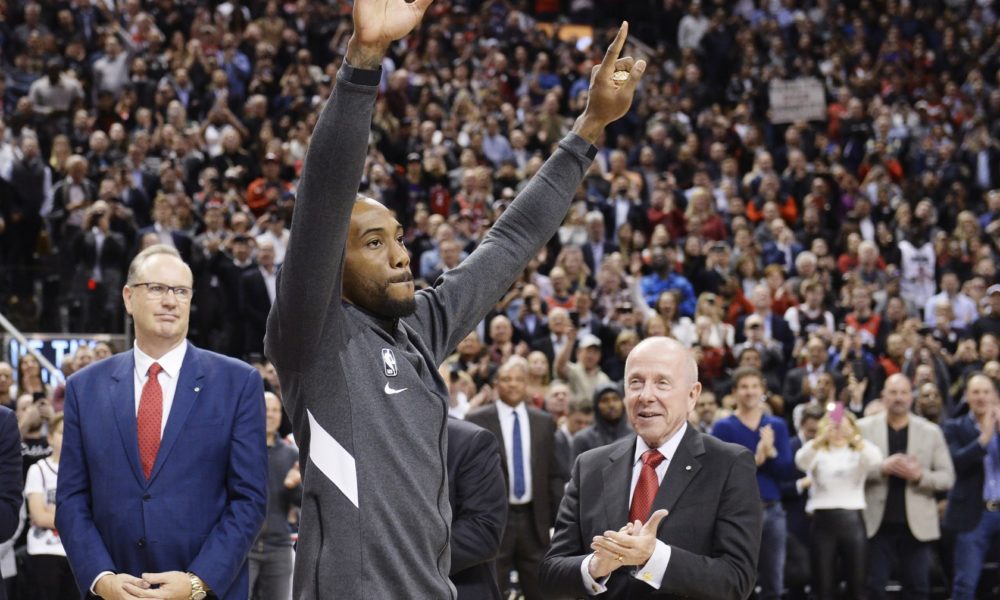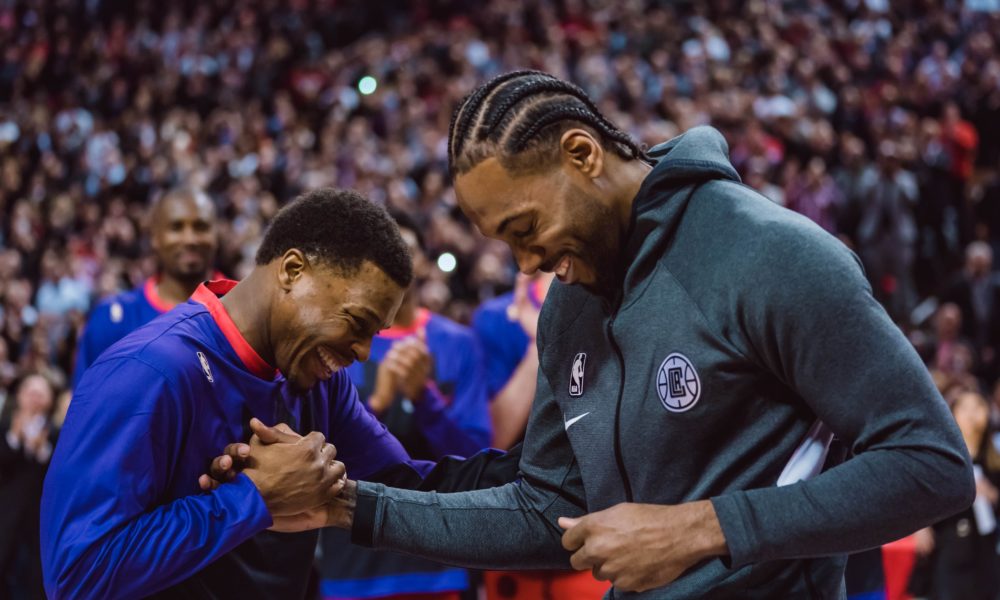After losing 112-92 to the Los Angeles Clippers, the Toronto Raptors are officially in a slump. Despite the emotional jolt of Kawhi Leonard’s return to Toronto — his first since the championship, if his words before the game are to be believed — the Raptors couldn’t harness that energy on the court. In fact, a variety of players mentioned the lack of energy after the game. Kyle Lowry even said it’s so obvious that “everyone’s seeing it out there.”
Defensively, the Raptors tried to get that jolt of energy by double-teaming Leonard, forcing turnovers, and getting out in transition. It hardly worked that way. Toronto spent an entire half of basketball sending aggressive double-teams against Leonard, which fits with the Raptors’ season-long strategy of trying to force stars’ teammates to make plays. This game proved that such a focus won’t always work.
The Toronto Raptors have a player who can frustrate Kawhi Leonard. OG Anunoby seems engineered to guard dominant wing scorers like Leonard. Anunoby blocked two mid-range jumpers, one a turnaround and one a pull-up, which is nearly impossible against a player with the length and lift of Leonard. Anunoby had multiple tipped passes, deflecting the ball when Leonard tried to receive the pass or dribble. Anunoby was altogether effective, denying Leonard the ball, keeping him out of the lane, and staying with him to contest shots.
Yet the Toronto Raptors spent the entire first half insisting on sending double-teams against Leonard from simple angles while he faced the basket.
There are different types of double-teams. Toronto attacked Leonard from angles that he could see well in advance. Leonard watched the defender approach, surveyed the floor, and whipped the ball to the weak-side corner where a shooter, usually Patrick Beverly, waited to hoist open triples. Beverly shot three-of-five from deep in the first half, scoring 11 points, which was more than any Raptor had at the break. The double-teams rarely frustrated Leonard, and though they forced a few turnovers in the first half, they allowed far more open shots to good shooters.
Toronto could have used more subtle double-teams, attacking Leonard from differing angles on different plays. They could have waited for him to turn his back to the basket so that he didn’t see the defender, increasing the chances of a turnover and decreasing the ease of his passing angles.
Toronto found success double-teaming stars early, frustrating players like Nikola Vucevic, Damian Lillard, and, yes, Kawhi Leonard the last time Toronto faced the Clippers. But in recent weeks Jimmy Butler notched 12 assists in torching the Raptors and James Harden’s Rockets set Raptors records for opponents’ attempted and made 3s. Indiscriminate double-teams are not always a good defensive strategy, even if Toronto used it well early in the season. Teams scout opposing defenses, and to use the same defense in multiple games against Leonard is tempting fate.
Perhaps the best option would have been to not double-team Leonard at all. The Raptors spent the second half allowing Anunoby to guard Leonard alone, and he was fantastic. The Clippers scored a total of 48 points in the second half after notching 37 in the second quarter alone.
By refusing to enter defensive rotations unless otherwise forced, Toronto stemmed the flow of open 3s to their opponents; it turns out choosing to leave an opponent wide open may have its downsides. The Clippers shot seven-of-18 from deep in the first half and five-of-22 in the second. With Leonard fighting for every inch against Anunoby and his Clippers teammates actually facing defenders, the Clippers struggled to score. Gasol walled off the paint, as is his wont when he doesn’t have to cover too much ground in rotations. Pascal Siakam was brilliant defending the rim as a helper, swatting shots out of bounds and even chasing down two Paul George pull-up jumpers to block him from behind.
The Raptors cut the game to a five point deficit in the third quarter before the whole recipe stopped working. Toronto gave up a 12-0 run as they made a series of mental errors. Norman Powell threw away possessions by simply missing an open pass in transition or launching contested, early-clock triples. Pascal Siakam committed a charge. Serge Ibaka took, and missed, as many shots as he could handle. The house came crashing down just as quickly as it had been built.
Toronto’s offense stopped being able to score. Defensively they were excellent in the second half. Once they stopped telegraphing double teams from a mile away, the Clippers had to work much harder for points. But on the other end, Toronto couldn’t fix the basic flaws of their team.
Without Fred VanVleet, the Raptors don’t have nearly enough creators who can get downhill against a set defense. Even with him, it’s going to be a struggle. When Lowry and Ibaka were injured, the Raptors survived without offensive rebounding and hot three-point shooting, neither of which are completely dependable sources of offense. The Raptors’ cold shooting continued against the Clippers, finishing eight-of-36, or 22.2 percent, from deep. On one ugly possession in the first half, they collected three offensive rebounds but missed four triples before committing an offensive foul. The shooting was downright atrocious, and players admitted after the game that their defense was deflated by their inability to score.
Nick Nurse tried funky lineups to jump-start the offense. He played uber-gigantic lineups with Chris Boucher, Siakam, Ibaka, and Gasol. It didn’t work. Toronto’s flaws have been apparent in the past five games. Their offense is not dependable. Leonard guarded Lowry, and he was unable to score. George guarded Siakam, and he scored some points, but he didn’t warp the Clippers’ defense enough to create open shots for his teammates. No one on Toronto was able to create for the other Raptors. Still, there could be solutions on the horizon.
Lowry admits that he’s not all the way back, but he promises that he’ll be there. “[Since my return from injury,] I’ve had two good games and the rest have been shit, to be honest,” he said after the game. “Once I get back to where I was at the beginning of the season, it will be great. Right now, I’m just trying to work my way in and trying to figure it out, and get better and get better over time. But right now I’m nowhere near where I want to be physically and where I need to be.”
“Give me another two weeks or a week, and I’m going to get there. Once I’m there, yeah,” he paused and smiled mid-sentence, as if daring an opponent to face him when he finally has his legs underneath him, “we’ll see.”
The Raptors are currently playing with the structure and intensity of under-cooked meatloaf. Their shooting could not be worse. Their defense, at least for one half against the Clippers, handed open shots to their opponents on a platter. Lowry and Ibaka are playing as poor as players of their caliber could possibly play. However, Toronto can only improve from on those lows. Their shooting will improve, as will their defensive structures and focus. Lowry will return to, at minimum, an All-Star level. The Raptors are coming. But as for how long it will take, Lowry was exactly right. We’ll see.



